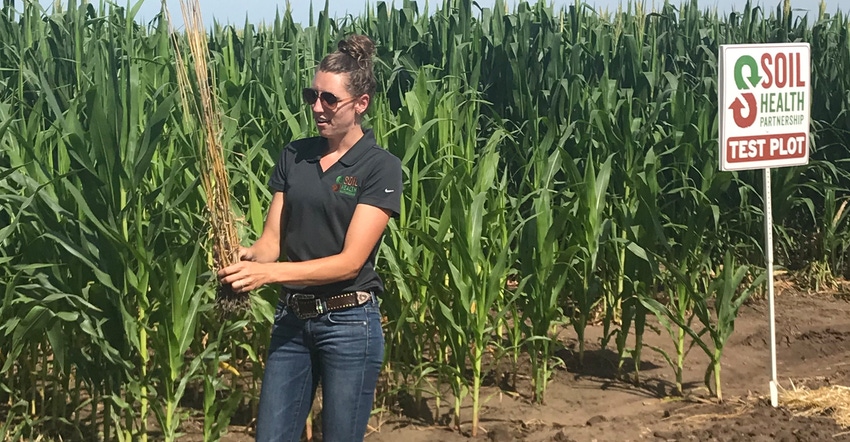October 4, 2019

Soil is farmers’ most valuable resource. That’s why Lisa Kubik, a Soil Health Partnership field manager covering eastern Iowa, believes making sure the soil is doing its best for the environment and for the economics of the farm is a relatable way to define soil health.
“The topic of soil health is very popular,” she notes. “When you look at it from the farm level and start accessing the differences in soil that was treated well versus neglected, differences are easy to see.”
One way to demonstrate this concept is with a rainfall simulator. Kubik collects soil from a conventionally tilled field and from a neighboring no-till field to make a fair comparison. Each sample receives the same amount of water to simulate a rain event. If the water is unable to penetrate the soil, it flows into a collection basin.
“The no-till soil is more porous and absorbs the water,” Kubik says. “A lot of water runs off the conventionally tilled sample.”
Soil health defined
Kubik uses this demonstration to encourage farmers to walk into their fields to assess their own farm’s soil health. “Farmers get a very good idea of soil health if they walk across the land after a rain event,” she says. “If you have good soil health, you’ll notice rain has soaked into the soil versus running off. In a field with poorer soil health, you’ll also see ponding.”
She encourages farmers to look at their tillage system to determine what improvements can be made to minimize soil disturbance. “If you’re doing full tillage, take a look at vertical tillage. If you’re already doing vertical tillage, take a look at no-till or strip till,” Kubik says. “Minimizing the number of trips across the field with tillage tools improves soil health.”
Kubik also wants farmers to think about compaction that is caused by tillage systems. “We lose a lot of our soil structure and essentially create a floor within that soil where the water cannot permeate by intensive tilling of the soil,” she says. “Plant health is impacted when we can’t get the water through the soil.”
Reducing compaction takes time, and cover crops can help. She encourages farmers to start with oats or turnips in the fall if they want to avoid termination before spring planting, but she touts the benefits of winter rye breaking up compaction as well.
“The most important thing to remember with cover crops is to plan ahead. Don’t rush through the seed selection and application process. Think about your herbicide program and about termination,” she advises.
Small changes make big difference
Kubik believes small changes on the farm can make a big difference in soil health over time. “I encourage farmers to try something different, even on a small scale, to add value to the farm,” she says. “Making small adjustments and adding new practices over time makes a big difference.”
It’s a process to improve soil health, and it’s a process to learn a new practice, she adds. “The Soil Health Partnership farmers we work with love to talk about the practices they use and the benefits they see. While they each have different reasons for trying new practices, a common theme among those using no-till is their ability to get into fields to plant and harvest sooner. That’s a big deal when there’s rain in the forecast.”
Kubik takes her knowledge home to the family farm in Tama County. Along with her in-laws, Kubik and her husband, Alex, grow corn, soybeans and alfalfa alongside a cow-calf herd. The land they farm has been in a no-till system for more than 40 years, and they continue to expand their use of cover crops for the added benefits of controlling weeds and erosion on the rolling hills they farm, as well as adding organic matter. Cover crops also provide an economical feed source for the grazing cattle.
“We use 4R Plus practices like no-till, cover crops and split-applied nutrient applications because we want to keep the family farm prosperous so future generations can enjoy making a living on this land,” Kubik says. “We want to keep the ground productive and maintain its value as cropland. We are also interested in making sure the water is clean for us and everyone downstream.”
For more information, visit 4R Plus.
Source: 4R Plus, which is responsible for information provided and is owned by source. Informa Business Media and subsidiaries aren’t responsible for content in this information asset.
You May Also Like




